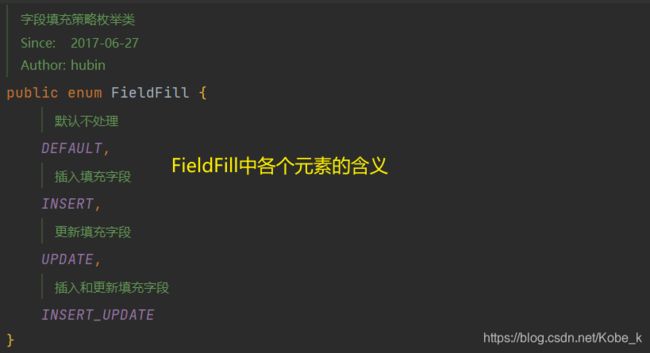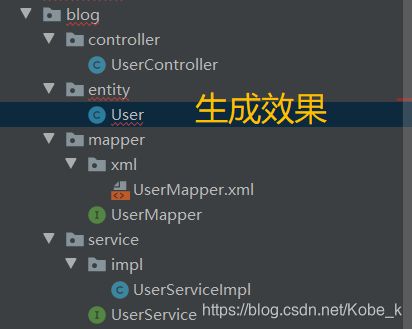MyBatis Plus 入门篇 通俗易懂
基本介绍
- MyBatisPlus是Mybatis的增强版,能够简化Dao层的CURD操作,所有的CRUD代码它都可以自动化完成
- 官方介绍:MyBatis-Plus(简称 MP)是一个 MyBatis 的增强工具,在 MyBatis 的基础上只做增强不做改变,为简化开发、提高效率而生。
- 还有一些其他的工具,例如 Spring Data JPA 、 tk-mapper(通用Mapper)
- 需要有 MyBatis、Spring、SpringMVC 的基础
- 官网:https://mp.baomidou.com/

特性
- 无侵入:只做增强不做改变,引入它不会对现有工程产生影响,如丝般顺滑
- 损耗小:启动即会自动注入基本 CURD,性能基本无损耗,直接面向对象操作
- 强大的 CRUD 操作:内置通用 Mapper、通用 Service,仅仅通过少量配置即可实现单表大部分CRUD 操作,更有强大的条件构造器,满足各类使用需求
- 支持 Lambda 形式调用:通过 Lambda 表达式,方便的编写各类查询条件,无需再担心字段写错
- 支持主键自动生成:支持多达 4 种主键策略(内含分布式唯一 ID 生成器 - Sequence),可自由配置,完美解决主键问题
- 支持 ActiveRecord 模式:支持 ActiveRecord 形式调用,实体类只需继承 Model 类即可进行强大的 CRUD 操作
- 支持自定义全局通用操作:支持全局通用方法注入( Write once, use anywhere )
- 内置代码生成器:采用代码或者 Maven 插件可快速生成 Mapper 、 Model 、 Service 、 Controller 层代码,支持模板引擎,更有超多自定义配置等您来使用
- 内置分页插件:基于 MyBatis 物理分页,开发者无需关心具体操作,配置好插件之后,写分页等同于普通 List 查询
- 分页插件支持多种数据库:支持 MySQL、MariaDB、Oracle、DB2、H2、HSQL、SQLite、Postgre、SQLServer 等多种数据库
- 内置性能分析插件:可输出 Sql 语句以及其执行时间,建议开发测试时启用该功能,能快速揪出慢查询
- 内置全局拦截插件:提供全表 delete 、 update 操作智能分析阻断,也可自定义拦截规则,预防误操作
- 支持的数据库:
- mysql 、 mariadb 、 oracle 、 db2 、 h2 、 hsql 、 sqlite 、 postgresql 、 sqlserver
- 达梦数据库 、 虚谷数据库 、 人大金仓数据库
快速开始
当我们需要导入第三方的组件时,一般会有一下几个步骤:
- 导入对应的依赖
- 研究依赖如何配置
- 代码如何编写
- 提高扩展技术能力
开始创建项目:
- 创建数据库
DROP TABLE IF EXISTS user CREATE TABLE USER ( id BIGINT ( 20 ) NOT NULL COMMENT '主键ID', NAME VARCHAR ( 30 ) NULL DEFAULT NULL COMMENT '姓名', age INT ( 11 ) NULL DEFAULT NULL COMMENT '年龄', email VARCHAR ( 50 ) NULL DEFAULT NULL COMMENT '邮箱' PRIMARY KEY ( id )); INSERT INTO USER ( id, NAME, age, email ) VALUES ( 1, 'Jone', 18, 'test1@baomidou.com' ),( 2, 'Jack', 20, 'test2@baomidou.com' ),( 3, 'Tom', 28, 'test3@baomidou.com' ),( 4, 'Sandy', 21, 'test4@baomidou.com' ),( 5, 'Billie',24,'test5@baomidou.com' ); - 编写项目,初始化项目,导入依赖,这里使用的 mybatis-plus 的版本是 3.0.5
<!-- 数据库驱动 --> <dependency> <groupId>mysql</groupId> <artifactId>mysql-connector-java</artifactId> </dependency> <!-- lombok --> <dependency> <groupId>org.projectlombok</groupId> <artifactId>lombok</artifactId> </dependency> <!-- mybatis-plus --> <!-- mybatis-plus 是自己开发,并非官方的! --> <dependency> <groupId>com.baomidou</groupId> <artifactId>mybatis-plus-boot-starter</artifactId> <version>3.0.5</version> </dependency> 注意: 尽量不要同时导入 mybatis 和 mybatis-plus,会存在版本的差异 - 连接数据库,这一步和 mybatis 相同
# mysql 5 驱动不同 com.mysql.jdbc.Driver # mysql 8 驱动不同com.mysql.cj.jdbc.Driver、需要增加时区的配置serverTimezone=GMT%2B8 spring.datasource.username=root spring.datasource.password=123456 spring.datasource.url=jdbc:mysql://localhost:3306/mybatis_plus?useSSL=false&useUnicode=true&characterEncoding=utf-8&serverTimezone=GMT%2B spring.datasource.driver-class-name=com.mysql.cj.jdbc.Driver - 传统方式就要开始写 pojo=>dao(连接mybatis,配置mapper.xml文件)=>service=>controller
使用了 MyBatis-Plus 之后只需要声明一下接口就可以用了
这里搭配了Lombok插件,简化pojo,实际开发中不推荐使用lombok
MyBatis-Plus 帮我们写好了 SQL 以及方法// pojo实体类 @Data @AllArgsConstructor @NoArgsConstructor public class User { private Long id; private String name; private Integer age; private String email; } ---------------------------------------------------------------------------- // mapper接口 import com.baomidou.mybatisplus.core.mapper.BaseMapper; import com.learn.pojo.User; import org.springframework.stereotype.Repository; // 在对应的Mapper上面继承基本的类 BaseMapper @Repository // 代表持久层 public interface UserMapper extends BaseMapper<User> { // 所有的CRUD操作都已经编写完成了 // 你不需要像以前的配置一大堆文件了! } ---------------------------------------------------------------------------- //注意点,我们需要在主启动类上去扫描我们的mapper包下的所有接口 @SpringBootApplication @MapperScan("com.learn.mapper") public class Application { public static void main(String[] args) { SpringApplication.run(QuickStartApplication.class, args); } } ---------------------------------------------------------------------------- // 测试类测试 @SpringBootTest class MybatisPlusApplicationTests { // 继承了BaseMapper,所有的方法都来自己父类 // 我们也可以编写自己的扩展方法! @Autowired private UserMapper userMapper; @Test void contextLoads() { // 参数是一个 Wrapper ,条件构造器,这里我们先不用 写为null即可 // 查询全部用户 List<User> users = userMapper.selectList(null); users.forEach(System.out::println); } }
配置日志
在做完初步的测试后,会发现我们无法知道MybatisPlus发送的SQL语句以及执行的一些状态,那么我们可以配置一下日志输出
# 配置日志
mybatis-plus.configuration.log-impl=org.apache.ibatis.logging.stdout.StdOutImpl
CRUD操作及其拓展
插入操作
// 测试插入
@Test
public void testInsert(){
User user = new User();
user.setName("username");
user.setAge(3);
user.setEmail("qqemail@qq.com");
int result = userMapper.insert(user); // 会帮我们自动生成id
System.out.println(result); // 受影响的行数
System.out.println(user); // 发现,id会自动回填
}
当我们执行了代码,查看日志后发现,我们插入的数据中的 id 是一个很长的字符串
数据库插入的 id 的默认值为:全局的唯一id
此时能够发现数据库并没有配置主键自增,实际上MybatisPlus这里使用的主键生成策略是雪花算法
主键生成策略
可以参考一下:分布式系统唯一ID生成方案
雪花算法 SnowFlake
SnowFlake是Twitter开源的分布式ID生成算法,结果是一个long型的ID。
其核心思想是:使用41bit作为毫秒数,10bit作为机器的ID(5个bit是数据中心,5个bit的机器ID),12bit作为毫秒内的流水号(意味着每个节点在每毫秒可以产生 4096 个 ID),最后还有一个符号位,永远是0。
具体实现的代码可以参看 https://github.com/twitter/snowflake。
配置主键自增
- 在实体类字段上
@TableId(type = IdType.AUTO)
// 对应数据库中的主键 (可以使用uuid、自增id、雪花算法、redis、zookeeper等)
@TableId(type = IdType.AUTO)
private Long id;
关于IdType的枚举,可以看一下源码,源码都是中文的,不用担心看不懂
更新操作
// 测试更新
@Test
public void testUpdate(){
User user = new User();
// 通过条件自动拼接动态sql
user.setId(1240620674645544965L);
user.setName("关注公众号:狂神说");
user.setAge(20);
// 注意:updateById 但是参数是一个 对象!
int i = userMapper.updateById(user);
System.out.println(i);
}
- 执行后查看输出日志,可以发现,MyBatisPlus 自动实现了动态配置SQL
自动填充
像创建时间和修改时间这样的操作一般都是自动化完成的,不希望手动的去更新。
在阿里巴巴开发手册中明确提出,所有的数据库表要包括 gmt_create、gmt_modified 而且需要自动化生成

| 方式一:数据库级别(工作中不允许你修改数据库) |
-
再次测试插入方法,我们需要修改实体类,匹配数据库表的字段
private Date createTime; private Date updateTime;
| 方式二:代码级别 |
-
实体类字段属性上需要增加注解
// 字段自动填充 // 字段添加自动填充方式 @TableField(fill = FieldFill.INSERT) private Date createTime; @TableField(fill = FieldFill.INSERT_UPDATE) private Date updateTime; -
编写处理器来处理这个注解即可
import com.baomidou.mybatisplus.core.handlers.MetaObjectHandler; import jdk.internal.instrumentation.Logger; import lombok.extern.slf4j.Slf4j; import org.apache.ibatis.reflection.MetaObject; import org.springframework.stereotype.Component; import java.util.Date; @Slf4j @Component // 一定不要忘记把处理器加到IOC容器中! public class MyMetaObjectHandler implements MetaObjectHandler { // 插入时的填充策略 @Override public void insertFill(MetaObject metaObject) { log.info("start insert fill....."); // setFieldValByName(String fieldName, Object fieldVal, MetaObject metaObject this.setFieldValByName("createTime",new Date(),metaObject); this.setFieldValByName("updateTime",new Date(),metaObject); //3.3.0版本之后官方推荐使用下面的方法,此处时3.0.5版本 this.strictInsertFill(metaObject, "createTime", LocalDateTime.class, LocalDateTime.now()); // 起始版本 3.3.0(推荐使用) this.fillStrategy(metaObject, "createTime", LocalDateTime.now()); // 也可以使用(3.3.0 该方法有bug请升级到之后的版本如`3.3.1.8-SNAPSHOT`) /* 上面选其一使用,下面的已过时(注意 strictInsertFill 有多个方法,详细查看源码) */ } // 更新时的填充策略 @Override public void updateFill(MetaObject metaObject) { log.info("start update fill....."); this.setFieldValByName("updateTime",new Date(),metaObject); } } -
测试插入
// 测试插入 @Test public void testInsert(){ User user = new User(); user.setName("Irving"); user.setAge(3); user.setEmail("test6@qq.com"); int result = userMapper.insert(user); // 帮我们自动生成id System.out.println(result); // 受影响的行数 System.out.println(user); // 发现,id会自动回填 } -
测试更新、观察时间即可
// 测试更新 @Test public void testUpdate(){ User user = new User(); // 通过条件自动拼接动态sql user.setId(8L); user.setName("Irving"); user.setAge(5); // 注意:updateById 但是参数是一个 对象! int i = userMapper.updateById(user); System.out.println(user); }
乐观锁
| 乐观锁 : 顾名思义十分乐观,它总是认为不会出现问题,无论干什么不去上锁!如果出现了问题,再次更新值测试,涉及到一个Version的字段,用版本号来判断有没有更新 |
| 悲观锁:顾名思义十分悲观,它总是认为总是出现问题,无论干什么都会上锁!再去操作! |
乐观锁实现方式:
- 取出记录时,获取当前
version - 更新时,带上这个
version - 执行更新时,
set version = newVersion where version = oldVersion - 如果
version不对,就更新失败
乐观锁:1、先查询,获得版本号 version = 1
-- A
update user set name = "name", version = version + 1
where id = 2 and version = 1
-- B 线程抢先完成,这个时候 version = 2,会导致 A 修改失败!
update user set name = "name", version = version + 1
where id = 2 and version = 1
| 测试一下MP的乐观锁 |
首先配置好数据库和实体类
MP 乐观锁插件的配置只需两步
3. 插件配置
// 扫描我们的 mapper 文件夹
@MapperScan("com.learn.mapper")
@EnableTransactionManagement
@Configuration // 配置类
public class MyBatisPlusConfig {
// 注册乐观锁插件
@Beanpublic
OptimisticLockerInterceptor optimisticLockerInterceptor() {
return new OptimisticLockerInterceptor();
}
// 如果是使用spring的xml配置文件,则添加bean即可
// - 注解实体字段
@Version必须要!@Version //乐观锁Version注解 private Integer version;
测试乐观锁
-
成功案例 ---- 单个线程查询并修改
// 测试乐观锁成功! @Test public void testOptimisticLocker(){ // 1、查询用户信息 User user = userMapper.selectById(1L); // 2、修改用户信息 user.setName("Jane"); user.setEmail("test1@qq.com"); // 3、执行更新操作 userMapper.updateById(user); } -
失败案例 ---- 多个线程
// 测试乐观锁失败!多线程下 @Test public void testOptimisticLocker2(){ // 线程 1 User user = userMapper.selectById(1L); user.setName("Jane01"); user.setEmail("test1@qq.com"); // 模拟另外一个线程执行了插队操作 User user2 = userMapper.selectById(1L); user2.setName("Jane02"); user2.setEmail("24736743@qq.com"); userMapper.updateById(user2); // 可以使用自旋锁来多次尝试提交! userMapper.updateById(user); // 如果没有乐观锁就会覆盖插队线程的值! }
可以观察到数据库中的值是Jane02那么代码中后面的更新操作就是失败了
查询操作
// 测试查询
@Test
public void testSelectById(){
User user = userMapper.selectById(1L);
System.out.println(user);
}
// 测试批量查询!
@Test
public void testSelectByBatchId(){
List<User> users = userMapper.selectBatchIds(Arrays.asList(1, 2, 3));
users.forEach(System.out::println);
}
// 按条件查询之一使用map操作
@Test
public void testSelectByBatchIds(){
HashMap<String, Object> map = new HashMap<>();
// 自定义要查询
map.put("name","James");
map.put("age",3);
List<User> users = userMapper.selectByMap(map);
users.forEach(System.out::println);
}
分页查询
分页查询的使用十分广泛,大部分的网站都是用了分页查询
- 原始的 limit 进行分页
- pageHelper 第三方插件
- MP 其实也内置了分页插件!
使用方法
- 配置拦截器
//Spring boot方式 @MapperScan("com.learn.mapper") @EnableTransactionManagement @Configuration // 配置类 public class MybatisPlusConfig { // 分页插件 详细的代码使用可以看官方文档 @Bean public PaginationInterceptor paginationInterceptor() { return new PaginationInterceptor(); } } - 直接使用Page对象即可
// 测试分页查询 @Test public void testPage(){ // 参数一:当前页 // 参数二:页面大小 // 使用了分页插件之后,所有的分页操作也变得简单的! Page<User> page = new Page<>(2,5); userMapper.selectPage(page,null); page.getRecords().forEach(System.out::println); System.out.println(page.getTotal()); }
删除操作
// 测试删除
@Test
public void testDeleteById(){
userMapper.deleteById(1L);
}
// 通过id批量删除
@Test
public void testDeleteBatchId(){
userMapper.deleteBatchIds(Arrays.asList(1240620674645544961L,1240620674645544962L));
}
// 通过map删除
@Test
public void testDeleteMap(){
HashMap<String, Object> map = new HashMap<>();
map.put("name","James");
userMapper.deleteByMap(map);
}
逻辑删除
- 物理删除 :从数据库中直接移除
- 逻辑删除 :再数据库中没有被移除,而是通过一个变量来让他失效! deleted = 0 => deleted = 1
例如:管理员可以查看被删除的记录!防止数据的丢失,类似于回收站!
上手测试一下:
-
实体类中添加字段属性,一定要添加一个注解!!
@TableLogic //逻辑删除 private Integer deleted; -
配置!添加组件,要分别在Java配置类和是Spring的配置文件中进行配置
//配置类 import com.baomidou.mybatisplus.core.injector.ISqlInjector; import com.baomidou.mybatisplus.extension.injector.LogicSqlInjector; import org.springframework.context.annotation.Bean; import org.springframework.context.annotation.Configuration; @Configuration public class MyBatisPlusConfiguration { @Bean public ISqlInjector sqlInjector() { return new LogicSqlInjector(); } }# application.properties文件中添加 # 配置逻辑删除 mybatis-plus.global-config.db-config.logic-delete-value=1 # 逻辑已删除值(默认为 1) mybatis-plus.global-config.db-config.logic-not-delete-value=0 # 逻辑未删除值(默认为 0) -
测试一下
// 测试删除 @Test public void testDeleteById(){ userMapper.deleteById(1L); }
以上的所有CRUD操作及其扩展操作,我们都必须精通掌握!这会大大提高你的工作和写项目的效率
性能分析插件
我们在开发的过程中,会遇到一些慢SQL的情况。一般是通过测试、压测之类的发现
MP也提供了性能分析插件 ==> 性能分析拦截器:用于输出每条 SQL 语句及其执行时间
注意: 该插件 3.2.0 以上版本移除推荐使用第三方扩展 执行SQL分析打印 功能
使用步骤:
- 在Java配置类中添加组件
/** * SQL执行效率插件 */ @Bean @Profile({"dev","test"})// 设置 dev test 环境开启,保证我们的效率 public PerformanceInterceptor performanceInterceptor() { PerformanceInterceptor performanceInterceptor = new PerformanceInterceptor(); //在工作中,不允许用户等待 performanceInterceptor.setMaxTime(100); //单位(ms) 设置sql执行的最大时间,如果超过了则不执行 performanceInterceptor.setFormat(true); //format SQL SQL是否格式化,默认false return performanceInterceptor; } - 在
application.properties配置文件中设置当前环境为开发环境或测试环境# 设置开发环境 spring.profiles.active=dev - 测试一下,用之前的查询测试

条件构造器 Wrapper
Wrapper 十分重要,当我们需要写一些复杂的SQL就可以使用它来替代
import com.baomidou.mybatisplus.core.conditions.query.QueryWrapper;
import com.kuang.mapper.UserMapper;
import com.kuang.pojo.User;
import org.junit.jupiter.api.Test;
import org.springframework.beans.factory.annotation.Autowired;
import org.springframework.boot.test.context.SpringBootTest;
import java.util.List;
import java.util.Map;
@SpringBootTest
public class WrapperTest {
@Autowired
private UserMapper userMapper;
@Test
void contextLoads() {
// 查询name不为空并且邮箱不为空的用户,年龄大于等于12
QueryWrapper<User> wrapper = new QueryWrapper<>();
wrapper
.isNotNull("name")
.isNotNull("email")
.ge("age",12);
userMapper.selectList(wrapper).forEach(System.out::println); // 和我们刚才学习的map对比一下
}
@Test
void test2(){
// 查询名字Kobe
QueryWrapper<User> wrapper = new QueryWrapper<>();
wrapper.eq("name","Kobe");
User user = userMapper.selectOne(wrapper); // 查询一个数据,出现多个结果使用List 或者 Map
System.out.println(user);
}
@Test
void test3(){
// 查询年龄在 20 ~ 30 岁之间的用户
QueryWrapper<User> wrapper = new QueryWrapper<>();
wrapper.between("age",20,30); // 区间
Integer count = userMapper.selectCount(wrapper);// 查询结果数
System.out.println(count);
}
// 模糊查询
@Test
void test4(){
// 名字中没有 e 的,邮箱以t开头的
QueryWrapper<User> wrapper = new QueryWrapper<>();
// 左:%e 右:e% 左和右就是指通配符%在左边还是在右边 如果没指定则两边都有 %e%
wrapper.notLike("name","e") // %e%
.likeRight("email","t"); // t%
List<Map<String, Object>> maps = userMapper.selectMaps(wrapper);
maps.forEach(System.out::println);
}
// 模糊查询
@Test
void test5(){
QueryWrapper<User> wrapper = new QueryWrapper<>();
// id 在子查询中查出来
wrapper.inSql("id","select id from user where id<10");
List<Object> objects = userMapper.selectObjs(wrapper);
objects.forEach(System.out::println);
}
//测试六
@Test
void test6(){
QueryWrapper<User> wrapper = new QueryWrapper<>();
// 通过id进行排序
wrapper.orderByAsc("id");
List<User> users = userMapper.selectList(wrapper);
users.forEach(System.out::println);
}
// 还有很多的方法可以使用,可以自己去测试一下
}
代码自动生成器
AutoGenerator 是 MyBatis-Plus 的代码生成器,通过 AutoGenerator 可以快速生成 Entity、Mapper、Mapper XML、Service、Controller 等各个模块的代码,极大的提升了开发效率。
详情可以参考官方文档
import com.baomidou.mybatisplus.annotation.DbType;
import com.baomidou.mybatisplus.annotation.FieldFill;
import com.baomidou.mybatisplus.annotation.IdType;
import com.baomidou.mybatisplus.generator.AutoGenerator;
import com.baomidou.mybatisplus.generator.config.DataSourceConfig;
import com.baomidou.mybatisplus.generator.config.GlobalConfig;
import com.baomidou.mybatisplus.generator.config.PackageConfig;
import com.baomidou.mybatisplus.generator.config.StrategyConfig;
import com.baomidou.mybatisplus.generator.config.po.TableFill;
import com.baomidou.mybatisplus.generator.config.rules.DateType;
import com.baomidou.mybatisplus.generator.config.rules.NamingStrategy;
import java.util.ArrayList;
// 代码自动生成器
public class AutoCode {
public static void main(String[] args) {
// 构建一个代码生成器
AutoGenerator mpg = new AutoGenerator();
//配置策略
// 1 全局配置
GlobalConfig gc = new GlobalConfig();
String projectPath = System.getProperty("user.dir"); // 获取用户目录
gc.setOutputDir(projectPath + "/src/main/java"); // 设置输出目录
gc.setAuthor("Hey"); // 设置作者名字
gc.setOpen(false); // 生成过后是否打开资源管理器
gc.setFileOverride(false); // 设置是否覆盖已有文件
gc.setServiceName("%sService"); // 去掉Service中的I前缀
gc.setIdType(IdType.ID_WORKER); // 设置主键生成策略
gc.setDateType(DateType.ONLY_DATE); // 设置日期类型
gc.setSwagger2(true);
mpg.setGlobalConfig(gc);
// 2 设置数据源
DataSourceConfig dsc = new DataSourceConfig();
String url = "jdbc:mysql://47.115.8.47:3306/learn?useSSL=false&useUnicode=true&characterEncoding=utf-8&serverTimezone=GMT%2B8";
String driverName = "com.mysql.cj.jdbc.Driver";
dsc.setUrl(url)
.setDriverName(driverName)
.setUsername("root")
.setPassword("123456")
.setDbType(DbType.MYSQL);
mpg.setDataSource(dsc);
// 3 包的配置
PackageConfig pc = new PackageConfig();
pc.setModuleName("blog");
pc.setParent("com.learn");
pc.setEntity("entity");
pc.setMapper("mapper");
pc.setService("service");
pc.setController("controller");
mpg.setPackageInfo(pc);
// 4 策略配置
// 策略配置
StrategyConfig strategy = new StrategyConfig();
strategy.setInclude("user"); // 设置要映射的表名
strategy.setNaming(NamingStrategy.underline_to_camel);
strategy.setColumnNaming(NamingStrategy.underline_to_camel);
strategy.setEntityLombokModel(true);
strategy.setLogicDeleteFieldName("deleted");
// 自动填充配置
TableFill gmt_creat = new TableFill("gmt_creat", FieldFill.INSERT);
TableFill gmt_modified = new TableFill("gmt_modified", FieldFill.INSERT_UPDATE);
ArrayList<TableFill> tableFills = new ArrayList<>();
tableFills.add(gmt_creat);
tableFills.add(gmt_modified);
strategy.setTableFillList(tableFills);
//乐观锁配置
strategy.setVersionFieldName("version");
// Rest风格
strategy.setRestControllerStyle(true);
// 设置成 localhost:8080/hello_id_2 这样的一个下划线风格
strategy.setControllerMappingHyphenStyle(true);
mpg.setStrategy(strategy);
//执行
mpg.execute();
}
}
- MyBatis-Plus 从 3.0.3 之后移除了代码生成器与模板引擎的默认依赖,需要手动添加相关依赖
- 添加 代码生成器 依赖
- 添加 模板引擎 依赖,MyBatis-Plus 支持 Velocity(默认)、Freemarker、Beetl,用户可以选择自己熟悉的模板引擎,如果都不满足您的要求,可以采用自定义模板引擎
<dependency>
<groupId>com.baomidougroupId>
<artifactId>mybatis-plus-generatorartifactId>
<version>3.0.5version>
dependency>
<dependency>
<groupId>org.apache.velocitygroupId>
<artifactId>velocity-engine-coreartifactId>
<version>2.2version>
dependency>
<dependency>
<groupId>org.freemarkergroupId>
<artifactId>freemarkerartifactId>
<version>2.3.30version>
dependency>
<dependency>
<groupId>com.ibeetlgroupId>
<artifactId>beetlartifactId>
<version>3.1.3.RELEASEversion>
dependency>
注意!如果您选择了非默认引擎,需要在 AutoGenerator 中 设置模板引擎。
AutoGenerator generator = new AutoGenerator();
// set freemarker engine
generator.setTemplateEngine(new FreemarkerTemplateEngine());
// set beetl engine
generator.setTemplateEngine(new BeetlTemplateEngine());
// set custom engine (reference class is your custom engine class)
generator.setTemplateEngine(new CustomTemplateEngine());
其他配置可以去官方文档查看使用方法,文档是中文的,通俗易懂,https://mp.baomidou.com/guide/
















